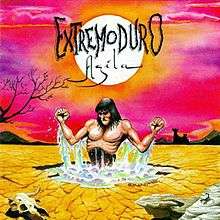Agila (album)
Agila (Spanish dialect Castúo[1] for "Liven up")[2] is the sixth studio album by Spanish hard rock band Extremoduro. Recorded in 1995, produced by Iñaki "Uoho" Antón and released on 23 February 1996.[3]
| Agila | ||||
|---|---|---|---|---|
 | ||||
| Studio album by | ||||
| Released | 23 February 1996 | |||
| Recorded | 1995, Estudios BOX | |||
| Genre | Hard rock | |||
| Length | 43:22 | |||
| Label | DRO | |||
| Producer | Iñaki "Uoho" Antón | |||
| Extremoduro chronology | ||||
| ||||
It's often considered as their breakthrough album. Published in 1996, a year after its preceding album, Pedrá, it featured instruments that hadn't appeared before on any of Extremoduro's albums. It includes some of the most famous songs by the band: "So payaso", "Buscando una luna", "Prometeo", "Sucede" and "El día de la bestia", which was included on the movie of the same name soundtrack.
Track listing
| No. | Title | Writer(s) | Length |
|---|---|---|---|
| 1. | "Buscando una luna" | Roberto Iniesta | 4:13 |
| 2. | "Prometeo" | Roberto Iniesta | 3:29 |
| 3. | "Sucede" | Roberto Iniesta | 3:09 |
| 4. | "So payaso" | Roberto Iniesta | 4:43 |
| 5. | "El día de la bestia" | Roberto Iniesta | 4:46 |
| 6. | "Tomás" | Roberto Iniesta | 1:29 |
| 7. | "¡Qué sonrisa tan rara!" | Roberto Iniesta | 3:18 |
| 8. | "Cabezabajo" | Roberto Iniesta | 3:42 |
| 9. | "Ábreme el pecho y registra" | Roberto Iniesta | 3:32 |
| 10. | "Todos me dicen" | Roberto Iniesta | 4:13 |
| 11. | "Correcaminos, estate al loro" | Roberto Iniesta / Ramone | 2:34 |
| 12. | "La carrera" | Roberto Iniesta / Zosi Pascual | 2:18 |
| 13. | "Me estoy quitando" | Roberto González / Pedro Ramírez/ José Manuel Ramírez / Jesús Ortiz | 2:12 |
- 2011 edition bonus tracks
| No. | Title | Writer(s) | Length |
|---|---|---|---|
| 14. | "Sucede (Nueva Mezcla 2004)" | Roberto Iniesta | 3:05 |
Personnel
- Extremoduro
- Roberto "Robe" Iniesta – vocals; acoustic and electric guitars; keyboards on #10
- Iñaki "Milindris" Setién – guitars except on #04, 09, 12, 13
- Ramón "Mon" Sogas – bass except on #04, 07, 09, 13
- Alberto "Capi" Gil – drums except on #04, 05, 09, 13
- Additional personnel
- Iñaki "Uoho" Antón – guitars except on 06, 07, 09, 10, 13; bass on #04, 07, 09; keyboards on #01, 05, 10; piano on #04; hammond organ on #11; percussion on #02, 03, 08, 11, 14
- Fito Cabrales – Spanish guitar on #06; 13; cajón on #13
- Albert Pla – vocals on #07
- José Sañudo – saxophone on #01, 02, 03, 06, 08, 10, 14; flute on #13
- Sergio (Ratanera) – drums on #04, 09
- Pepegu (Ratanera) – bass on #04, 09
- Isaac (Ratanera) – guitars on #04, 09
- Sime – trombone on #04
- "Reverendo" – hammond organ on #06
- Josu Monje – programming on #05; drums on #05
- Elena – chorus on #05
Charts and certifications
Chart performance
| Chart (1996) | Peak position |
|---|---|
| Spanish Album Charts[4] | 13 |
Certifications
| Region | Certification | Certified units/sales |
|---|---|---|
| Spain (PROMUSICAE)[5] | 2× Platinum | 200,000^[5] |
|
*sales figures based on certification alone | ||
Reception
| Review scores | |
|---|---|
| Source | Rating |
| El País | |
Rolling Stone magazine referred to it as a masterpiece of the Spanish rock.[7] In 2007 it was ranked by American magazine Al Borde as the 227th best Ibero-American album of all time,[8] being a relative low position because at the time of the album's release the band was still unknown to Latin America.[9] In 2012 was ranked as the 12th best album of the Spanish rock according to Rolling Stone.[10]
The track "So payaso" was ranked as the 103rd best song of the rock en español ever by the magazine Al borde,[11] in addition to winning the award for best music video of the Spanish Music Awards in 1997.[12] Likewise, it was included as DLC in the video game Guitar Hero III: Legends of Rock.[13]
References
- "'Agila': el disco con el que Extremoduro subió a los altares del rock". Libertad Digital (in Spanish). 23 February 2014.
- "Billboard". 17 June 1996.
- https://www.amazon.com/Agila-Extremoduro/dp/B000059QJX/ref=pd_sim_m_3
- Sánchez, J.M. (7 June 2011). "Extremoduro, el valor de lo esencial" (in Spanish). Retrieved 11 January 2015.
- "Biografía de Extremoduro" (in Spanish). Retrieved July 31, 2015.
- Carlos Marcos (March 1996). "Disco de la semana: Extremoduro - Agila". El País de las Tentaciones. Retrieved 8 August 2019.
- "Las 10 Razones Por Las Que Extremoduro Arrasa". Archived from the original on 2013-10-31. Retrieved 2013-12-09.
- "250 albums del Rock Iberoamericano" (in Spanish). Archived from the original on 2011-01-02. Retrieved 2013-12-09.
- Menéndez Flores, Javier (23 May 2013). Extremoduro. De profundis. La historia autorizada. Grijalbo Ilustrados (in Spanish). p. 210. ISBN 9788425350337.
- "Los 50 Mejores Discos Del Rock Espanol" (in Spanish). Archived from the original on 7 March 2014. Retrieved 7 March 2014.
- "Las 500 del Rock Iberoamericano: 50 Años Para No Olvidar (200-101)" (in Spanish).
- "Premios de la musica 1997" (in Spanish). Archived from the original on 2010-10-27. Retrieved 2013-12-09.
- http://majornelson.com/2007/12/20/guitar-hero-iii-tracks-one-free-12-20-07/
External links
- Official website (in Spanish)